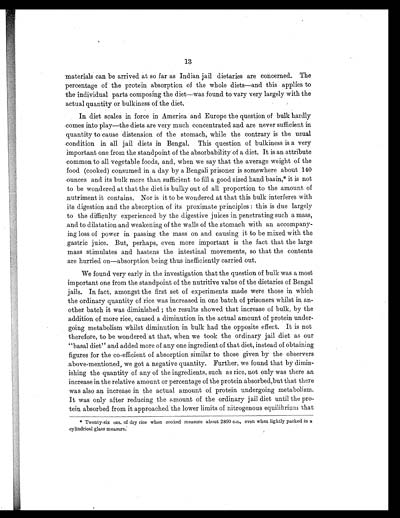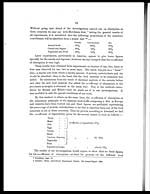Medicine - Institutions > Army health reports and medical documents > Scientific memoirs by officers of the Medical and Sanitary Departments of the Government of India > Number 37 - Investigations on Bengal jail dietaries > Front matter
(23) Page 13
Download files
Individual page:
Thumbnail gallery: Grid view | List view

13
materials can be arrived at so far as Indian jail dietaries are concerned. The
percentage of the protein absorption of the whole diets—and this applies to
the individual parts composing the diet—was found to vary very largely with the
actual quantity or bulkiness of the diet.
In diet scales in force in America and Europe the question of bulk hardly
comes into play—the diets are very much concentrated and are never sufficient in
quantity to cause distension of the stomach, while the contrary is the usual
condition in all jail diets in Bengal. This question of bulkiness is a very
important one from the standpoint of the absorbability of a diet. It is an attribute
common to all vegetable foods, and, when we say that the average weight of the
food (cooked) consumed in a day by a Bengali prisoner is somewhere about 140
ounces and its bulk more than sufficient to fill a good sized hand basin,* it is not
to be wondered at that the diet is bulky out of all proportion to the amount of
nutriment it contains. Nor is it to be wondered at that this bulk interferes with
its digestion and the absorption of its proximate principles: this is due largely
to the difficulty experienced by the digestive juices in penetrating such a mass,
and to dilatation and weakening of the walls of the stomach with an accompany-
ing loss of power in passing the mass on and causing it to be mixed with the
gastric juice. But, perhaps, even more important is the fact that the large
mass stimulates and hastens the intestinal movements, so that the contents
are hurried on—absorption being thus inefficiently carried out.
We found very early in the investigation that the question of bulk was a most
important one from the standpoint of the nutritive value of the dietaries of Bengal
jails. In fact, amongst the first set of experiments made were those in which
the ordinary quantity of rice was increased in one batch of prisoners whilst in an-
other batch it was diminished; the results showed that increase of bulk, by the
addition of more rice, caused a diminution in the actual amount of protein under-
going metabolism whilst diminution in bulk had the opposite effect. It is not
therefore, to be wondered at that, when we took the ordinary jail diet as our
"basal diet" and added more of any one ingredient of that diet, instead of obtaining
figures for the co-efficient of absorption similar to those given by the observers
above-mentioned, we got a negative quantity. Further, we found that by dimin-
ishing the quantity of any of the ingredients, such as rice, not only was there an
increase in the relative amount or percentage of the protein absorbed, but that there
was also an increase in the actual amount of protein undergoing metabolism.
It was only after reducing the amount of the ordinary jail diet until the pro-
tein absorbed from it approached the lower limits of nitrogenous equilibrium that
* Twenty-six ozs. of dry rice when cooked measure about 2800 c.c., even when lightly packed in a
cylindrical glass measure.
Set display mode to: Large image | Zoom image | Transcription
Images and transcriptions on this page, including medium image downloads, may be used under the Creative Commons Attribution 4.0 International Licence unless otherwise stated. ![]()
| Permanent URL | https://digital.nls.uk/75032784 |
|---|




